 當前位置:首頁 > 新聞動態 > 行業新聞
當前位置:首頁 > 新聞動態 > 行業新聞新冠肺炎“炎癥風暴”是近期公眾關注的諸多熱點話題之一;所謂“炎癥風暴”即全身炎癥反應綜合征(SIRS),人體的炎癥因子,不僅可以殺掉病毒,也會給自身造成損害,某些新冠患者后期可能突然啟動了一個“炎癥風暴”,結果導致各個器官的功能衰竭。那么應該如何應對“炎癥風暴”呢?中南大學湘雅醫學院林韶輝博士撰文“有效針對新冠肺炎的“炎癥風暴”——Omega-3多不飽和脂肪酸”,表達了自己的一些觀點,或許會給大家一些思考和啟發。
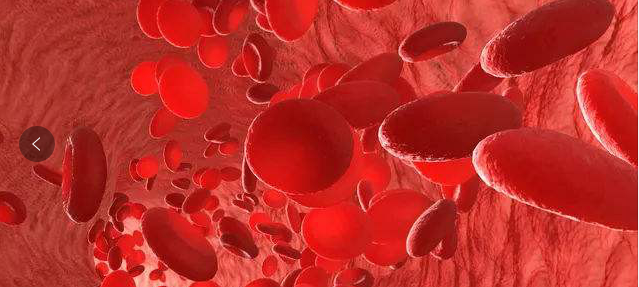
一、新冠肺炎專家說
1. 武漢金銀潭醫院:上海中山醫院重癥醫學科副主任鐘鳴醫生(2020年1月24到達武漢),2020年2月3日,南方人物周刊對鐘醫生進行獨家專訪,提到救治初期,所面臨的困難之中,有的新冠患者后期可能突然啟動了一個“炎癥風暴”,這種炎癥風暴導致了各個器官的功能衰竭,一旦進入這個狀態,我們的治療很難把它拉回來。
2. 武漢大學中南醫院:《美國醫學會雜志》2月7日在線發布了武漢大學中南醫院重癥監護室(ICU)主任彭志勇博士領銜的一項回顧性分析,研究團隊認為,新冠肺炎致死的三大主要機制:
中性粒細胞增多,與細胞因子風暴有關;
D-二聚體升高反映凝血激活,提示持續的炎癥反應;
血尿素升高提示急性腎損傷,這是感染、休克和缺氧的綜合結果。
3. 種種跡象表明,這些重癥患者中發生了不可逆轉的“炎癥風暴”。而一旦患者發生“炎癥風暴”,糖皮質激素是對抗炎癥風暴的武器之一,可以給免疫系統“滅火”,減輕機體損傷。不過,糖皮質激素是一把“雙刃劍”。一方面它可以減輕炎癥反應,有利于改善缺氧、呼吸窘迫癥狀;但長期大劑量使用也可能引發諸多不良反應。不少經過大劑量激素治療的“非典”患者,都留下了如股骨頭壞死等嚴重后遺癥。
二、“炎癥風暴”與Omega-3多不飽和脂肪酸
3. Omega-3 PUFA對抗炎癥反應的作用機制
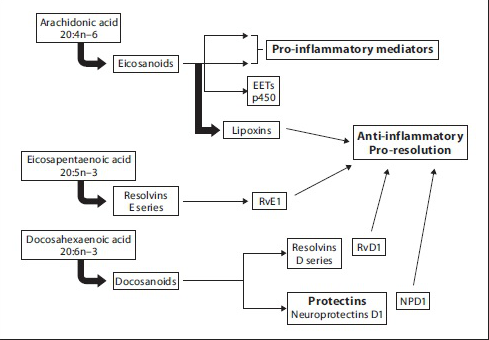
圖1. 長鏈不飽和脂肪酸代謝示意圖
4. 多種文獻證明,為了減少患者還可能發生爆發性炎癥反應,使用高純度的 Omega-3 PUFA制劑,可以減低炎癥風暴的發生風險。具體表現
4.1 Omega-3 PUFA富集于細胞膜,參與炎癥反應調控過程,減少炎性細胞產生促炎性細胞因子;
Omega-3 PUFA富集于細胞膜,提高細胞膜EPA和DHA脂肪酸的比例[11, 12],影響胞內信號傳導,抑制炎癥相關的轉錄因子NF-kappa B的轉錄活性[13, 14],從而減少促炎性細胞因子TNF-alpha、IL-6 和IL-8等的表達[15]。
花生四烯酸類脂質經一系列酶催化產生促炎癥調節作用的前列腺素(PGE2)和白三烯B4等。這些促炎性介質進而可激活中性粒細胞、巨噬細胞,刺激炎癥細胞因子TNF-α、IL-1、IL-2、IL-8和干擾素(Interferon, IFN)等釋放增多。Omega-3和Omega-6兩類 PUFA競爭相同的脂肪酸代謝酶(Elovl5和FADS2)系統[16-18],從而干擾促炎性介質的生成。
EPA和DHA經代謝產生消散素(Resolvins)和保護素(Protections)。實驗研究證實,消散素和保護素在關節炎[19]、結腸炎[20]、哮喘[21, 22]等多種炎性疾病中發揮重要的抗炎作用[23, 24] 。例如,resolvin E1,resolvin D1和protectin D1能抑制浸潤性中性粒細胞的細胞遷移,從而減輕局部炎癥[24]。此外,resolvin D1和protectin D1還能抑制TNF-α and IL-1β的產生,從而減弱炎癥反應[25, 26]。
5. Omega-3 PUFA緩解炎癥的具體臨床獲益
5.1 C反應蛋白等炎癥指標顯著下降,血紅蛋白和白細胞、血小板等細胞類群總量顯著上升。
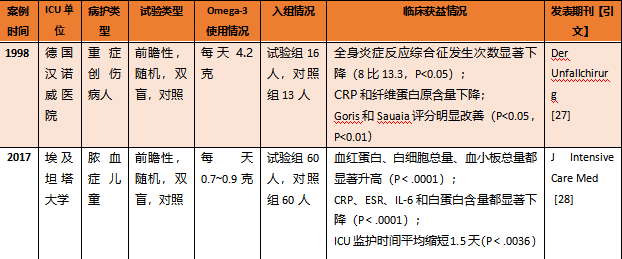
表1. ICU患者使用Omega-3 PUFA帶來的生理指標和臨床指標獲益
5.2 敗血癥狀明顯下降,治療用抗生素使用時間縮短,全身炎癥反應綜合征減少,器官功能障礙后遺癥發生率減少,死亡率下降;
美國田納西大學附屬醫院和西班牙多所醫院的臨床研究表明,對于重癥創傷患者和膿毒癥患者等ICU患者,每天1~3克Omega-3 PUFA營養液可以有效降低菌血癥、敗血癥并發癥發生(下降14%[29]~35%[30]),明顯降低治療用抗生素使用時間和腹腔內膿腫發生率[30]。而使用更高Omega-3 PUFA含量(4克以上)的營養液后,創傷病人全身炎癥反應綜合征發生人數顯著下降[27];膿毒癥、敗血癥患者的器官功能障礙發生率減少達到43%[31],死亡率顯著下降13.1%[29]~19.4%[31]。
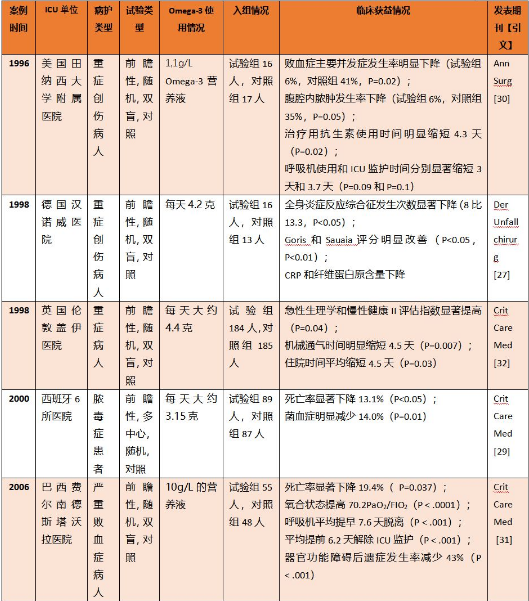
表2. 創傷患者和敗血癥患者使用Omega-3 PUFA的臨床獲益
5.3 改善氧合狀態,減少呼吸機使用,縮短ICU監護時間;
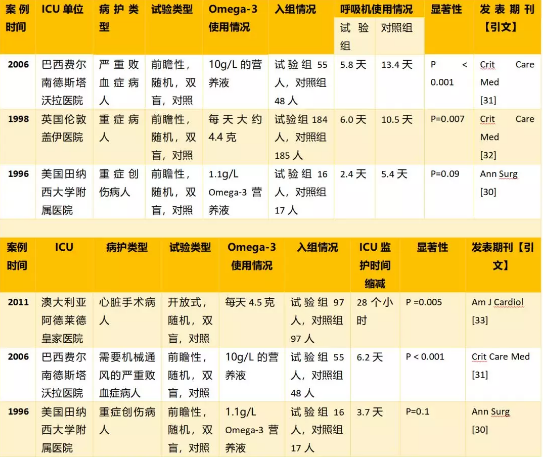
6.2 生物利用度高,保證體內有效富集。
6.3 添加中鏈甘油三酯(MCTs),促進Omega-3 PUFA快速細胞富集,為重癥患者的癥狀緩解贏得時間。添加MCT的Omega-3脂肪乳的體內富集時間更短(術后第六天即檢測到病患血清磷脂和紅細胞細胞膜中的EPA和DHA顯著升高)[35],激發免疫更強(第六天起外周血細胞釋放的白三烯B5含量已增長約2倍)[36];
參考文獻
1.Bone, R.C., C.J. Grodzin, and R.A. Balk, Sepsis: a new hypothesis for pathogenesis of the disease process. Chest, 1997. 112(1): p. 235-43.
2.Dobson, G.P., Addressing the Global Burden of Trauma in Major Surgery. Front Surg, 2015. 2: p. 43.
3.Binkowska, A.M., G. Michalak, and R. Slotwinski, Current views on the mechanisms of immune responses to trauma and infection. Cent Eur J Immunol, 2015. 40(2): p. 206-16.
4.Molfino, A., et al., Omega-3 Polyunsaturated Fatty Acids in Critical Illness: Anti-Inflammatory, Proresolving, or Both? Oxid Med Cell Longev, 2017. 2017: p. 5987082.
5.Alazawi, W., et al., Inflammatory and Immune Responses to Surgery and Their Clinical Impact. Ann Surg, 2016. 264(1): p. 73-80.
6.Hatakeyama, N. and N. Matsuda, Alert cell strategy: mechanisms of inflammatory response and organ protection. Curr Pharm Des, 2014. 20(36): p. 5766-78.
7.Matsuda, N., Alert cell strategy in SIRS-induced vasculitis: sepsis and endothelial cells. J Intensive Care, 2016. 4: p. 21.
8.Manson, J., C. Thiemermann, and K. Brohi, Trauma alarmins as activators of damage-induced inflammation. Br J Surg, 2012. 99 Suppl 1: p. 12-20.
9.Uddin, M. and B.D. Levy, Resolvins: natural agonists for resolution of pulmonary inflammation. Prog Lipid Res, 2011. 50(1): p. 75-88.
10.Barnig, C., N. Frossard, and B.D. Levy, Towards targeting resolution pathways of airway inflammation in asthma. Pharmacol Ther, 2018. 186: p. 98-113.
11.Walker, C.G., et al., The Pattern of Fatty Acids Displaced by EPA and DHA Following 12 Months Supplementation Varies between Blood Cell and Plasma Fractions. Nutrients, 2015. 7(8): p. 6281-93.
12.Mayer, K., et al., Omega-3 vs. omega-6 lipid emulsions exert differential influence on neutrophils in septic shock patients: impact on plasma fatty acids and lipid mediator generation. Intensive Care Med, 2003. 29(9): p. 1472-81.
13.Novak, T.E., et al., NF-kappa B inhibition by omega -3 fatty acids modulates LPS-stimulated macrophage TNF-alpha transcription. Am J Physiol Lung Cell Mol Physiol, 2003. 284(1): p. L84-9.
14.Lo, C.J., et al., Fish oil decreases macrophage tumor necrosis factor gene transcription by altering the NF kappa B activity. J Surg Res, 1999. 82(2): p. 216-21.
15.Calder, P.C., Omega-3 fatty acids and inflammatory processes. Nutrients, 2010. 2(3): p. 355-74.
16.de Gomez Dumm, I.N. and R.R. Brenner, Oxidative desaturation of alpha-linoleic, linoleic, and stearic acids by human liver microsomes. Lipids, 1975. 10(6): p. 315-7.
17.Hagve, T.A. and B.O. Christophersen, Effect of dietary fats on arachidonic acid and eicosapentaenoic acid biosynthesis and conversion to C22 fatty acids in isolated rat liver cells. Biochim Biophys Acta, 1984. 796(2): p. 205-17.
18.Hagve, T.A. and B.O. Christophersen, Evidence for peroxisomal retroconversion of adrenic acid (22:4(n-6)) and docosahexaenoic acids (22:6(n-3)) in isolated liver cells. Biochim Biophys Acta, 1986. 875(2): p. 165-73.
19.Lima-Garcia, J.F., et al., The precursor of resolvin D series and aspirin-triggered resolvin D1 display anti-hyperalgesic properties in adjuvant-induced arthritis in rats. Br J Pharmacol, 2011. 164(2): p. 278-93.
20.Arita, M., et al., Resolvin E1, an endogenous lipid mediator derived from omega-3 eicosapentaenoic acid, protects against 2,4,6-trinitrobenzene sulfonic acid-induced colitis. Proc Natl Acad Sci U S A, 2005. 102(21): p. 7671-6.
21.Aoki, H., et al., Resolvin E1 dampens airway inflammation and hyperresponsiveness in a murine model of asthma. Biochem Biophys Res Commun, 2008. 367(2): p. 509-15.
22.Haworth, O., et al., Resolvin E1 regulates interleukin 23, interferon-gamma and lipoxin A4 to promote the resolution of allergic airway inflammation. Nat Immunol, 2008. 9(8): p. 873-9.
23.Serhan, C.N., et al., Anti-microinflammatory lipid signals generated from dietary N-3 fatty acids via cyclooxygenase-2 and transcellular processing: a novel mechanism for NSAID and N-3 PUFA therapeutic actions. J Physiol Pharmacol, 2000. 51(4 Pt 1): p. 643-54.
24.Serhan, C.N., et al., Resolvins: a family of bioactive products of omega-3 fatty acid transformation circuits initiated by aspirin treatment that counter proinflammation signals. J Exp Med, 2002. 196(8): p. 1025-37.
25.Serhan, C.N., Pro-resolving lipid mediators are leads for resolution physiology. Nature, 2014. 510(7503): p. 92-101.
26.Serhan, C.N., N. Chiang, and T.E. Van Dyke, Resolving inflammation: dual anti-inflammatory and pro-resolution lipid mediators. Nat Rev Immunol, 2008. 8(5): p. 349-61.
27.Bastian, L., et al., [Clinical effects of supplemental enteral nutrition solution in severe polytrauma]. Unfallchirurg, 1998. 101(2): p. 105-14.
28.Al-Biltagi, M.A., et al., Beneficial Effects of Omega-3 Supplement to the Enteral Feeding in Children With Mild to Moderate Sepsis. J Intensive Care Med, 2017. 32(3): p. 212-217.
29.Galban, C., et al., An immune-enhancing enteral diet reduces mortality rate and episodes of bacteremia in septic intensive care unit patients. Crit Care Med, 2000. 28(3): p. 643-8.
30.Kudsk, K.A., et al., A randomized trial of isonitrogenous enteral diets after severe trauma. An immune-enhancing diet reduces septic complications. Ann Surg, 1996. 224(4): p. 531-40; discussion 540-3.
31.Pontes-Arruda, A., A.M. Aragao, and J.D. Albuquerque, Effects of enteral feeding with eicosapentaenoic acid, gamma-linolenic acid, and antioxidants in mechanically ventilated patients with severe sepsis and septic shock. Crit Care Med, 2006. 34(9): p. 2325-33.
32.Atkinson, S., E. Sieffert, and D. Bihari, A prospective, randomized, double-blind, controlled clinical trial of enteral immunonutrition in the critically ill. Guy's Hospital Intensive Care Group. Crit Care Med, 1998. 26(7): p. 1164-72.
33.Farquharson, A.L., et al., Effect of dietary fish oil on atrial fibrillation after cardiac surgery. Am J Cardiol, 2011. 108(6): p. 851-6.
34.Kemen, M., et al., Early postoperative enteral nutrition with arginine-omega-3 fatty acids and ribonucleic acid-supplemented diet versus placebo in cancer patients: an immunologic evaluation of Impact. Crit Care Med, 1995. 23(4): p. 652-9.
35.Senkal, M., et al., Supplementation of omega-3 fatty acids in parenteral nutrition beneficially alters phospholipid fatty acid pattern. JPEN J Parenter Enteral Nutr, 2007. 31(1): p. 12-7.
36.Koller, M., et al., Impact of omega-3 fatty acid enriched TPN on leukotriene synthesis by leukocytes after major surgery. Clin Nutr, 2003. 22(1): p. 59-64.
37.Senkal, M., et al., Modulation of postoperative immune response by enteral nutrition with a diet enriched with arginine, RNA, and omega-3 fatty acids in patients with upper gastrointestinal cancer. Eur J Surg, 1995. 161(2): p. 115-22.
38.Iwase, H., et al., Nutritional Effect of Oral Supplement Enriched in omega-3 Fatty Acids, Arginine, RNA on Immune Response and Leukocyte-platelet Aggregate Formation in Patients Undergoing Cardiac Surgery. Nutr Metab Insights, 2014. 7: p. 39-46.
39.Gianotti, L., et al., Effect of route of delivery and formulation of postoperative nutritional support in patients undergoing major operations for malignant neoplasms. Arch Surg, 1997. 132(11): p. 1222-9; discussion 1229-30.
40.Schilling, J., et al., Clinical outcome and immunology of postoperative arginine, omega-3 fatty acids, and nucleotide-enriched enteral feeding: a randomized prospective comparison with standard enteral and low calorie/low fat i.v. solutions. Nutrition, 1996. 12(6): p. 423-9.
41.Daly, J.M., et al., Enteral nutrition with supplemental arginine, RNA, and omega-3 fatty acids in patients after operation: immunologic, metabolic, and clinical outcome. Surgery, 1992. 112(1): p. 56-67
公司郵箱:wlf-0471@163.com
銷售熱線:400-6758105

天貓店二維碼

萬利福公眾號